|
Bedding plants and perennials provide
the home owner and landscaper with a multitude of colors and textures.
Unfortunately, numerous insects, mites and other invertebrates (ie. slugs,
sowbugs and millipedes) consider these same plants as food!
In order for you to manage the
activity and damage caused by these pests, you must understand "pest
management" and learn how to identify each pest. There are numerous
"bugs" in a healthy garden and most do no damage. A common
mistake is to spray anything that moves.
Each plant has a number of pests
that may attack the flowers, foliage, stems or roots. Some of these pests
will only attack a certain kind of plant. Other pests are generalists and
can feed on a variety of plants. This fact sheet will attempt to help you
identify the common "generalists" and suggest methods of keeping
them under control.
Pest Management
We now use the term "Pest Management" because we know from
experience that there is no way to totally rid the garden of unwanted
pests. We can merely attempt to keep pest numbers low to minimize their
damage - this is management.
When we use pest management there
are two important principles to remember: 1. The mere presence of a pest
is no reason to attempt control. 2. Reliance on a single control technique
will eventually fail.
Perhaps the old farmer's saying of
"plant five seeds - one for the weather, one for the crow, one for
bug, and two to grow!" should be considered in our gardens today.
Pests will always cause some damage to our flowers but is the amount of
damage unacceptable?
We know that complete reliance on
pesticides will eventually fail. In order to manage pests and their
damage, we need to use cultural (and mechanical) control (ie. resistant
plants, traps, crushing and sanitation) and biological control (ie.
predators, parasites and diseases) with chemical control.
Diagnosis of a
Problem
In order to manage pests, you must become a pest detective. To do this,
you must learn some of the terms used to describe pest damage to plants.
Generally, pests have either chewing or sucking mouthparts.
Pests with chewing mouthparts eat
portions of the plant. They may defoliate the plant by eating all the
leaves. They may only eat portions of leaves, resulting in skeletonized
foliage (the leaf tissues between the veins are eaten), notched foliage
(only the edge of the leaf is eaten), shot holed foliage (tiny holes in
the leaves), or shredded foliage (most of the leaf eaten except for the
major veins). Other chewing pests feed inside leaves (leaf miners), or
bore into stems and roots (borers).
Pests with sucking mouthparts
usually cause the plant to discolor or twist and curl. The plant may
discolor from tiny yellow speckles (spider mites), larger darkened spots
(plant bugs), or coatings of black sooty mold growing on honeydew deposits
(from aphids and whiteflies). Many plants react to the saliva and damage
of sucking pests by causing the foliage to curl or the young stems to
twist.
Locating an actual specimen of the
pest makes diagnosis easier. Many pests stay on the plant at all times and
a close inspection is all that is necessary. Others run or fly when
disturbed and you may need to sneak up on the plant to avoid scaring the
pests. Carefully approach the plant low to the ground and try to observe
the plant's upper and lower leaf surfaces without casting a shadow. Many
pests come out at night and you will have to look for these with a
flashlight.
If you have located a suspected pest
and you cannot identify it from the illustrations included here, try to
capture a specimen and take it to your county's Extension office. Most
pests can be placed in a dry jar or plastic bag. A dry tissue or paper
towel placed inside the jar or bag will keep the specimen dry. Be sure to
keep this container out of direct sunlight and get to the office as soon
as possible.
Snails and Slugs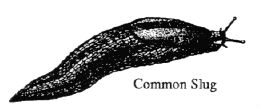
Snails and their
"shell-less" cousins, the slugs, are common residents in the
garden. Most of these feed on decaying organic matter but many can chew
the foliage of living plants. Snails and slugs prefer the dark and usually
do their damage at night, leaving ragged leaves. Use a flashlight at night
to detect these pests or look for the slime trails on damaged plant
foliage in the early morning.
These pests require high humidity or
moisture and usually reach pest status during wet years or during the
rainy periods of the spring and fall. Control is best achieved by making
the garden less suitable for snails and slugs. Remove excess mulch in
order to allow the soil to dry slightly, clean up any fresh plant debris
and open the plant canopy so that sunlight can reach the ground.
Snails and slugs are attracted to
the yeasty odor of beer and several traps are available that use this
odor. The larvae of fireflies, ground beetles and parasitic flies feed on
snails and slugs.
If habitat modification, traps or
natural predators do not reduce snails and slugs, pesticide-laced slug and
snail baits can be use.
Sowbugs and Pillbugs (Isopods)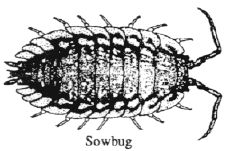
Isopods (commonly called pillbugs)
are not insects but relatives of the crab and shrimp. They have a head
with obvious antennae and a trunk region with 11 pairs of legs. They tend
to hide during the day and emerge at night to eat irregular holes in
leaves of young plants. These pests are easily detected at night with a
flashlight or by pulling back mulch around the plants.
Under normal conditions, these
general feeders rarely cause much damage to living plants since they
prefer to feed on decaying organic matter. During rainy weather or where
gardens are mulched too heavily and watered constantly, isopods can build
up large populations and cause visible damage.
The best control for isopods is to
remove excess mulch, use irrigation sparingly, and remove any old leaves
or dead plants immediately. This will reduce habitat and food necessary
for large populations. Some of the general insecticides also have sowbugs
or pillbugs on the labels and these can be used during wet seasons when
cultural controls are not effective.
Millipedes
Millipedes are often confused with
their fast running, predatory cousins, the centipedes. Millipedes have
heads with antennae and elongate trunks with 20 or more segments and two
pairs of legs per visible segment. These slow moving animals are usually
scavengers but occasionally feed on living plants, causing damage similar
to isopods. Centipedes have only one pair of legs per body segment, run
rapidly and are beneficial predators.
Control millipedes with the same
techniques used against isopods.
Spider Mites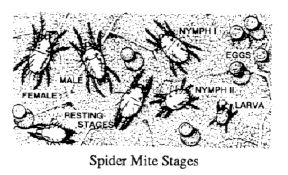
The most common spider mite
attacking bedding plants and perennials is the two-spotted spider mite.
This is a common pest in greenhouses and is often transplanted into the
garden with bedding plants. This mite, however, can overwinter as an adult
female hiding in protected areas.
The tiny mites are about 1/50 inch
long and usually feed on the undersides of leaves. You will need a 10x
hand lens to see these pests. They make tiny cuts into plant cells and
suck out the contents. This results in tiny yellow or white speckles on
the upper leaf surface. Spider mites also produce fine webbing which may
coat the plant when populations are extremely high. This is often easy to
observe in the morning dew.
The twospotted spider mite is a sun
and heat loving pest that can complete a cycle from egg to adult in less
than two weeks. Therefore, populations tend to be a real problem in the
heat of summer.
Since spider mites are not insects,
most insecticides are not effective for control. Beware of standard
insecticides that claim "mite suppression" on the label. Look
for true miticides or pesticides which claim "mite control".
Spider mites are best managed by
selecting bedding plants or new perennials which are not infested. Since
the mites are very tiny and prefer dry, sunny weather, attempt to grow
mite susceptible plants in the shade. A regular washing with a firm jet of
water (syringing) can help keep populations down.
Several of the insecticidal soaps
are also registered for mite control and can be effective if thoroughly
applied to the upper and lower leaf surfaces.
Most soap and miticide applications
will have to be repeated two to three times in order to kill resistant
eggs and resting stages of this pest.
Earwigs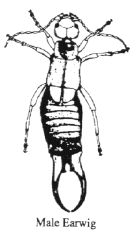
The European Earwig is a common
inhabitant of home gardens. The adults and nymphs have elongate bodies
ending in a pair of forceps like pinchers. Though these insects look
dangerous, they are harmless and can be considered beneficial when they
prey on other insects. Some of the larger males may be able to pinch soft
skin when picked up but most protect themselves by releasing a foul odor.
Unfortunately, European Earwigs are
omnivores that eat both plant and animal matter. When populations are low,
most people would never notice the occasional notch or hole in plant
foliage and flowers. When mild winters are combined with above normal
rainfall, Earwig populations explode and the adults and nymphs can be
packed by the hundreds in flowers and every other crack and crevice of the
garden. In most years, earwigs should be ignored or appreciated for their
predatory behavior.
When Earwigs reach intolerable
populations, they can be fairly easily controlled with standard
insecticides. Non-chemical control can also include the construction of
trap boards. These are two flat boards with 1/4 inch grooves tied together
so that the spaces are enclosed. The Earwigs like to hide in these spaces
and the boards can be collected regularly and dunked in soapy water to
kill the pests. Other cultural controls use the same types of habitat
modifications (ie. reducing mulch and sanitation) listed under isopods.
Plant Bugs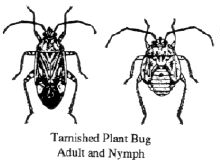
The tarnished plant bug and
fourlined plant bug are common sucking pests that attack a variety of
bedding and perennial plants. The daisy and mint families are especially
susceptible to attack. Both bugs are quick to fly and the nymphs quickly
run to the under surface of leaves when approached. They damage plants by
causing small (1/16 inch), round, sunken spots on the leaves. These spots
occur when the leaf bugs kill the leaf tissues during feeding. When these
spots are numerous, the entire leaf may curl and wither.
The tarnished plant bug has a
light-green nymph and the adult has mottled brown colors. The fourlined
plant bug has a bright red-orange nymph and the adults are lime green with
four black stripes.
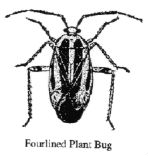
Damage to plants usually occurs in
the late-spring and early-summer when the nymphs are active. If this
activity is several weeks before flower bud initiation, no damage will be
evident at the time of flowering. However, early flowering plants can be
severely damaged. These are the plants that need protection.
Since the plant bug nymphs cause
most of the damage, control of this stage is suggested. Inspect plants
early and try to detect the first signs of the sucking damage. Small
numbers of nymphs can be dislodged from the plants into a container of
soapy water. Higher populations are best controlled with a registered
pesticide or insecticidal soap. Check the plants again in two weeks to
catch any late emerging nymphs.
Aphids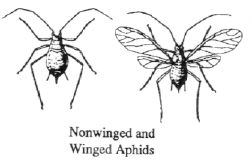
Every plant seems to have some type
of aphid which may feed on it. These pear-shaped, soft-bodied insects with
long legs and antennae may cause young, soft leaves and stems to twist and
curl. Aphids also produce considerable honeydew, a sugary excrement, which
is attractive to ants and may allow for the growth of black sooty mold.
Aphids may be any color with winged and nonwinged forms present in a
colony. Most of the reproduction is asexual, with females giving live
birth to the nymphs. Populations can therefore explode in a short period
of time.
Fortunately, there are numerous
predators and parasites which attack aphids. Lady beetles, lacewings and
aphid wasps are good examples. Learn how to identify these beneficials and
do not apply pesticides when they are active. Often, the beneficials
arrive after an aphid population has built up to alarming numbers. In
order to reduce these populations, the aphids can be washed off the plants
with a strong jet of water (syringing) or insecticidal soaps can be used.
Whiteflies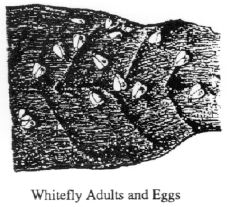
Whiteflies are not true flies but
relatives of aphids and scales. These 1/16 inch long pests are usually
first detected when the plant is touched and the small white insects take
flight. They damage plants by discoloring the leaves and depositing
honeydew.
Most of its life cycle is spent as a
sessile nymph and pupa attached to a leaf. Female whiteflies attach eggs
on leaf surfaces and the nymphs (called crawlers) move to find a suitable
spot to insert their sucking mouthparts and begin feeding as a sessile
nymph. The nymphs feed for about two weeks and excrete honeydew. They then
form a pupal stage from which the adult emerges.
Whiteflies are very difficult to
control because only the adults and crawlers are susceptible to normal
pesticides. However, insecticidal soaps seem to control some of the
recently settled nymphs.
It is best to avoid whiteflies. The
greenhouse whitefly normally gets started in the garden after being
brought in on bedding plants. Check new plants carefully for signs of
whiteflies.
Cutworms and Caterpillars

There are numerous caterpillars that
may be found attacking bedding plants and perennials. However, the most
damaging group are the cutworms that may kill newly-transplanted
seedlings. These thick bodied caterpillars live in the soil during the day
and emerge at night to find seedling plants. When a seedling is found, the
cutworm chews into the plant's stem at ground level and fells it like a
miniature lumberjack. The caterpillar may drag the plant back to its
burrow or may crawl under the dead plant to feed. When seedling stems get
too hard to cut off, the cutworms may crawl up to the leaves and dine
until daybreak. They then return to the soil to hide.
Examining the soil near recently
felled plants often exposes the culprit and allows one to eliminate it by
crushing or drowning in soapy water.
Cutworms can be controlled by
placing a plastic or cardboard collar around newly transplanted seedlings.
This ring should extend one to two inches into the soil and be three to
four inches tall. Several pesticides are registered for control of these
pests and the dusts applied to the soil seem to be most effective.
This publication contains
pesticide recommendations that are subject to change at any time. These
recommendations are provided only as a guide. It is always the pesticide
applicator's responsibility, by law, to read and follow all current label
directions for the specific pesticide being used. Due to constantly
changing labels and product registration, some of the recommendations
given in this writing may no longer be legal by the time you read them. If
any information in these recommendations disagrees with the label, the
recommendation must be disregarded. No endorsement is intended for
products mentioned, nor is criticism meant for products not mentioned. The
author, The Ohio State University and Ohio State University Extension
assume no liability resulting from the use of these recommendations.
Originally published
as HYG-2151-91
from the Ohio State
University Extension.
Written by David J. Shetlar.
Adapted for Kansas City by Savvygardener.com.
|










